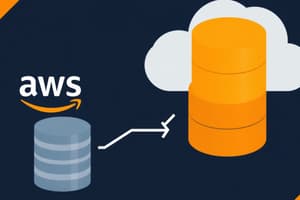Podcast
Questions and Answers
Which database service is best suited for applications that require complex queries and structured data?
Which database service is best suited for applications that require complex queries and structured data?
- Amazon S3
- Amazon RDS (correct)
- Amazon DynamoDB
- Amazon ElastiCache
What is a key characteristic of Amazon DynamoDB as a NoSQL database?
What is a key characteristic of Amazon DynamoDB as a NoSQL database?
- It automatically scales based on demand. (correct)
- It does not support high availability.
- It requires manual scaling of the database based on traffic.
- It is only compatible with document data models.
Which feature is NOT associated with Amazon RDS?
Which feature is NOT associated with Amazon RDS?
- Automatic backups and patching
- Support for multiple read replicas
- Compatible with NoSQL data models (correct)
- Multi-AZ deployments for high availability
When is it most appropriate to use AWS Managed Databases?
When is it most appropriate to use AWS Managed Databases?
What distinguishes Amazon Aurora from standard relational databases?
What distinguishes Amazon Aurora from standard relational databases?
What is one of the primary responsibilities of a user when managing an EC2 Hosted Database?
What is one of the primary responsibilities of a user when managing an EC2 Hosted Database?
In which scenario would you prefer using Amazon ElastiCache?
In which scenario would you prefer using Amazon ElastiCache?
Which of the following statements about NoSQL databases is incorrect?
Which of the following statements about NoSQL databases is incorrect?
What kind of deployment strategy does Amazon RDS utilize for high availability?
What kind of deployment strategy does Amazon RDS utilize for high availability?
Which database service would you typically use for real-time analytics applications?
Which database service would you typically use for real-time analytics applications?
When should AWS Database Migration Service (AWS DMS) be used?
When should AWS Database Migration Service (AWS DMS) be used?
Which of the following is a key feature of Amazon MemoryDB?
Which of the following is a key feature of Amazon MemoryDB?
For applications requiring extremely fast data access, which service would be the best option?
For applications requiring extremely fast data access, which service would be the best option?
What is a primary use case for AWS Schema Conversion Tool (AWS SCT)?
What is a primary use case for AWS Schema Conversion Tool (AWS SCT)?
Which AWS service is best for applications that need both caching speed and persistent data storage?
Which AWS service is best for applications that need both caching speed and persistent data storage?
Which statement about Amazon DynamoDB is true?
Which statement about Amazon DynamoDB is true?
Which of the following best describes the difference between managed and hosted databases?
Which of the following best describes the difference between managed and hosted databases?
When is it appropriate to use Amazon Aurora?
When is it appropriate to use Amazon Aurora?
What is a significant advantage of using Amazon ElastiCache?
What is a significant advantage of using Amazon ElastiCache?
Which platforms are supported by AWS DMS for heterogeneous migrations?
Which platforms are supported by AWS DMS for heterogeneous migrations?
Flashcards
AWS Managed Databases
AWS Managed Databases
AWS manages the maintenance, scaling, and backups of databases. Use for reduced operational tasks.
When to use EC2 Hosted Databases over Managed Databases?
When to use EC2 Hosted Databases over Managed Databases?
EC2 Hosted Databases: Use for highly customized database setups. Managed Databases: Use for reduced operational tasks.
Relational Database
Relational Database
Database with tables and predefined schemas.
Amazon Aurora
Amazon Aurora
Signup and view all the flashcards
Amazon ElastiCache
Amazon ElastiCache
Signup and view all the flashcards
Amazon RDS (Relational Database Service)
Amazon RDS (Relational Database Service)
Signup and view all the flashcards
What are the key features of Amazon Aurora?
What are the key features of Amazon Aurora?
Signup and view all the flashcards
NoSQL Database
NoSQL Database
Signup and view all the flashcards
What are the key features of Amazon DynamoDB?
What are the key features of Amazon DynamoDB?
Signup and view all the flashcards
What are the key features of Amazon ElastiCache?
What are the key features of Amazon ElastiCache?
Signup and view all the flashcards
Amazon MemoryDB
Amazon MemoryDB
Signup and view all the flashcards
AWS Database Migration Service (AWS DMS)
AWS Database Migration Service (AWS DMS)
Signup and view all the flashcards
AWS Schema Conversion Tool (AWS SCT)
AWS Schema Conversion Tool (AWS SCT)
Signup and view all the flashcards
EC2 Hosted Databases (self-managed)
EC2 Hosted Databases (self-managed)
Signup and view all the flashcards
Amazon DynamoDB
Amazon DynamoDB
Signup and view all the flashcards
What are the key features of Amazon RDS (Relational Database Service)?
What are the key features of Amazon RDS (Relational Database Service)?
Signup and view all the flashcards
Study Notes
AWS Database Services Overview
- AWS offers various database services for data storage, management, and analysis.
- Databases can be hosted on EC2 (self-managed) or fully managed by AWS.
Hosted vs. Managed Databases
- EC2 Hosted Databases: You manage the database installation, backups, scaling, patching, and updates on an Amazon EC2 instance. Suitable for custom configurations.
- AWS Managed Databases: AWS handles database maintenance, scaling, and backups. Your responsibility is the data and queries. Ideal for reduced operational overhead and scalability.
Relational Databases
- Relational databases store data in tables with predefined schemas, best for structured data and complex queries.
Amazon RDS (Relational Database Service)
- Fully managed relational database service.
- Supports MySQL, PostgreSQL, MariaDB, Oracle, SQL Server, and Amazon Aurora.
- Features automated backups, patching, multi-AZ deployments for high availability, and read replicas for scaling read capacity.
- Suitable for traditional web servers and enterprise applications.
Amazon Aurora
- High-performance, cost-effective relational database specifically for the cloud.
- Compatible with MySQL and PostgreSQL.
- Significantly faster than standard MySQL and PostgreSQL (up to 5x and 3x respectively).
- Offers automatic scaling and continuous backups.
- Ideal for cloud-native applications requiring high performance and scalability.
NoSQL Databases
- NoSQL databases handle unstructured or semi-structured data and are suited for flexible and scalable applications.
Amazon DynamoDB
- Fully managed NoSQL database for fast, predictable performance.
- Serverless architecture: automatic scaling based on demand.
- Supports key-value and document data models.
- High availability and low latency.
- Excellent for real-time applications, IoT, and mobile applications (e.g., gaming).
Amazon ElastiCache
- Fully managed in-memory NoSQL database.
- Supports Redis and Memcached engines.
- Extremely low-latency reads and writes making it great for caching frequently accessed data.
Memory-Based Databases
- Designed for extremely fast data access.
Amazon ElastiCache (Redis/Memcached)
- Use cases: real-time analytics, session data caching, game leaderboards.
Amazon MemoryDB for Redis
- Managed Redis-compatible database for high speed and durability.
- Offers durable storage with in-memory speed.
- Features high availability with multi-AZ support.
- Ideal for both caching and data persistence.
Database Migration Tools
- AWS provides tools for migrating databases from on-premises or other cloud environments to AWS.
AWS Database Migration Service (AWS DMS)
- Migrates databases to AWS with minimal downtime.
- Supports homogeneous (e.g., Oracle to RDS Oracle) and heterogeneous migrations (e.g., SQL Server to Aurora PostgreSQL).
- Suitable for migrating operational databases.
AWS Schema Conversion Tool (AWS SCT)
- Converts database schemas and code from one database engine to another.
- Automatically adapts schemas for heterogeneous migrations.
- Supports stored procedures, triggers, and functions.
- Suitable for converting schemas from on-premises to an AWS database.
Key Use Cases
- Relational Databases: RDS for standard, Aurora for high-performance cloud-native systems.
- NoSQL Databases: DynamoDB for scalable real-time applications, ElastiCache/MemoryDB for caching.
- Memory-Based Databases: MemoryDB for high-speed persistence.
- Database Migration: DMS for minimal downtime migration, SCT for converting schemas.
Summary comparison of services
- | Service | Database Type | Best for | Key Features |
- | ------------------- | ------------- | --------- |----------------|
- | Amazon RDS | Relational | Web apps, business apps | Multi-AZ, read replicas, managed backups |
- | Amazon Aurora | Relational | Cloud-native, high-performance | Faster than MySQL/PostgreSQL, continuous backups |
- | Amazon DynamoDB | NoSQL | Real-time applications, mobile, IoT | Serverless, low-latency |
- | Amazon ElastiCache | In-Memory NoSQL | Caching | Redis/Memcached, extremely low-latency |
- | Amazon MemoryDB | In-Memory NoSQL | Persistent, high-speed | Durable, Redis-compatible |
Key Takeaways
- Choose managed databases for reduced management (e.g., RDS).
- Use hosted databases on EC2 for full control.
- Select the appropriate service based on your specific application needs and requirements.
- Consider the performance, scalability, and operational burden of each service for optimal solution selection.
Studying That Suits You
Use AI to generate personalized quizzes and flashcards to suit your learning preferences.




